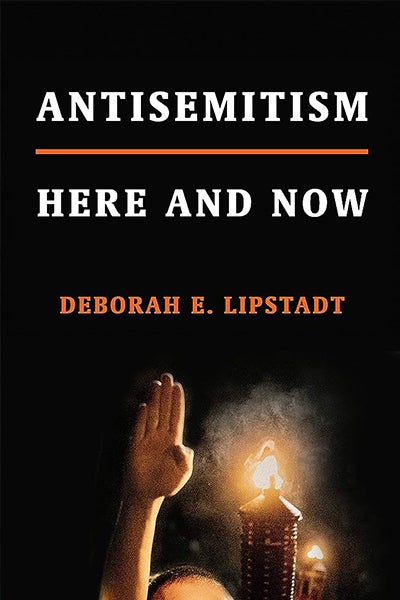Reviewed by Joshua Smith, Department of Philosophy
In Antisemitism: Here and Now, Deborah E. Lipstadt offers an accessible introduction to the issue of antisemitism. Lipstadt shows that this supposed artifact of history is alive today and is a consistent part of contemporary culture. The text employs an unconventional dialogical structure through imagined conversations between Lipstadt, a fictional student, Abigail, and a fictional colleague, Joe. This format personalizes the discourse, rendering the subject matter more approachable. However, it also prevents it from diving into the more nuanced aspects of the subject matter. Nevertheless, the book excels in its ability to illuminate the subtleties of antisemitism, extending beyond overt discrimination to expose more insidious forms of bias. It challenges the common misconception that antisemitism is either extinct or marginal.
The initial chapters attempts to define antisemitism, highlighting its irrational nature and the difficulty in pinning down a universally accepted definition. “We certainly know it when we see or hear it” she not notes glibly (13). She offers more precise definitions from other sources (15), which indicate that antisemitism is a perception of hatred and a latent structure of hostile beliefs towards Jews (15). Curiously, she somewhat dismisses these tighter definitions in suggesting that antisemitism does not warrant a definition at all, since it is not a coherent or rational idea to begin with (19).
After these comments on defining the central concept of the text, Lipstadt examines various types of antisemites, categorizing them as enablers, polite antisemites, and the clueless. This taxonomy helps understand the different ways antisemitism manifests, from those who unwittingly perpetuate stereotypes to those who consciously enable antisemitic rhetoric for political gain. To give just one example, in response to the horrific events of Charlottesville, VA, on August 17, 2017, then-President Donald Trump denounced the event and condemned the “egregious display of hatred, bigotry, and violence on many sides.” If you recall the details of the event, marchers were waving neo-Nazi flags and chanting antisemitic slogans. The “many sides” claim suggests that there was violence on both the attackers and the victims—which is inaccurate. This statement suggests to the public that there is something justified about the act of violence and that it is warranted in some way. Lipstadt comments, “Rather than be outraged by what they say and do, he [Trump] enables and emboldens them because it serves his political purposes.” It seems that Trump wanted to say that there were “good people” on each side of the protest while never coming to criticize the white supremacists who committed the violence overtly.
In subsequent chapters, Lipstadt confronts the irrationality of antisemitism, arguing against the effectiveness of education alone in combating such deeply ingrained prejudices. This matter raises one of the book’s fundamental philosophical issues, namely how one battles an irrational movement. If one is to combat and resist antisemitism, one must, it seems, use education. But, education appeals to reason and is ineffective in dissuading an irrational movement. Lipstadt acknowledges this difficulty and concludes, nonetheless, that one should resist antisemitism through education.
The book also delves into the thorny issues of Holocaust denial and the Israeli-Palestinian conflict. If these were hot issues by the time of the book’s publishing in 2019, she could not have anticipated how immensely relevant this is in 2023-2024. Now more than ever, we need reminders of the possibility that the Israeli-Palestinian conflict, as well as other topics, can be exploited to justify antisemitic views. In her discussion on this conflict, Lipstadt continually emphasizes the need for free speech, especially on university campuses, and pushes her reader to consider the balance between open debate and the continuance of stereotypes.
The book's most significant contribution—and its primary liability—emerges in handling the fine line between anti-Zionism and antisemitism. As the book uses the term, Zionism refers to the movement that proposes that the nation of Israel ought to occupy the geographic region of Palestine. This region roughly corresponds to the land of ancient Israel. Lipstadt recognizes the distinction between antisemitism and anti-Zionism and does not endorse Zionism. However, she also never defines antisemistim clearly in the book, despite offering examples of those who claim to be anti-Zionist as camouflage for antisemitism. This raises the difficult question: can any criticism of Israel be disentangled from antisemitism without a clear definition? While Lipstadt’s work is enlightening, its lack of a tight definition of the central concept, antisemitism, leads to unneeded ambiguity.
In its final chapters, the book shifts towards strategies for combating antisemitism, emphasizing the importance of nuanced approaches. Although the book recounts many events that display the evil of antisemitism, Lipstadt ends with optimism and encourages her reader to focus on the value of the Jewish tradition as well as the value of democratic ideals. Lipstadt discourages retreating into victimhood, underscoring the book's overarching message of a proactive, thoughtful response to antisemitism.
In conclusion, Antisemitism: Here and Now succeeds in illuminating the enduring presence of antisemitism in modern society. It challenges readers to recognize the subtle forms of this prejudice, as it navigates the difficulty of defining antisemitism. I recommend Lipstadt’s book to one who seeks an introduction to this topic.

